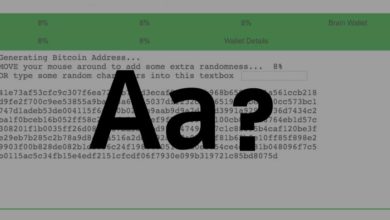What is ETH supply? How many ETH will ever exist? Ethereum supply explained
Ethereum supply – What is the total supply of Ethereum? How many ETH are in circulation and how many ETH will ever exist in the future? These are some of the most common questions regarding Ethereum and is being debated over and over on a number of forums.
As of writing this article there are around 114.3 Million Ethereum in circulation. This will keep changing and you can verify the circulating supply information on various Ethereum block explorers and websites like CoinMarketCap. However you’ll never find out the max supply information.
Nobody exactly knows how much of Ether will exist in the future. This is the fact. Unlike Bitcoin which has a capped supply of 21 million BTC; Ethereum has no supply cap. The max supply is infinite but that doesn’t mean ETH is a highly inflationary currency. We’ll get to that later.
But the thing is even the core Ethereum developers are unsure about the coin supply.
Ethereum coin supply forecast
Ethereum co-founder Vitalik Buterin once projected that the supply of ETH won’t even cross 100 million in the foreseeable future.
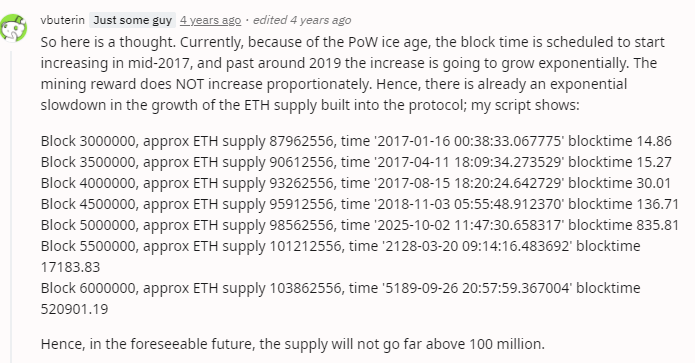
Later in 2020 Vitalik made a tweet stating that “According to white paper the supply of ETH should be 150 Million but Today it is just over 113 Million”.
ETH supply that the whitepaper says we would have today: 150.8 million
Actual ETH supply today: 111.3 millionSo please don't try to claim that ethereum is run by inflationist technocrats. pic.twitter.com/6CuPngDbHY
— vitalik.eth (@VitalikButerin) June 17, 2020
37 Million less Ether was mined than what was estimated in the white paper.
Clearly something went amiss with his calculations.
This unpredictable supply information and no limit cap on the total supply has raised concerns about inflation among many in the Ethereum community.
So why is there so much confusing regarding Ethereum supply? Here in this post we’ll clear out everything that you should need to know about Ethereum supply along with relevant sources.
Now before we get there let’s take a quick look at the difference between the Bitcoin blockchain and Ethereum blockchain.
Bitcoin and Ethereum blockchain – The difference
With Gold and Fiat currency only the rough estimate on supply count exists. Only in cryptocurrency the supply of coins can be verified to the exact numbers. The verifiability of assets is the strong and unique feature of the blockchain.
Like Bitcoin, Ethereum is a blockchain. Both the blockchains are public and immutable. All transactions remain public. Anybody can verify it but nobody can alter the data.
For now both the network uses Proof of Work to verify blocks but there are certain differences between the both.
While Bitcoin is deigned to be a global decentralized money Ethereum is a smart contracts platform. Anybody can build code and create smart contracts which anyone can connect and interact with. Other than this the technical specification of both the blockchain differs.
In Bitcoin most of the aspects such as block time, block rewards, halving, coin supply are all hard-coded. Whereas in Ethereum none of these are hard-coded and this is where the confusion arises.
Bitcoin blocks
Satoshi Nakamoto, the founder of Bitcoin has predefined the coin supply with Bitcoin.
Only 21 million Bitcoin will ever exist out of which 18.6 million has been already mined.
The block time target of Bitcoin is 10 minutes and the block rewards started with 50 BTC per block initially.
The rewards per block will cut into half every 210,000 blocks until the total supply limit of 21 million Bitcoin is mined.
The current Bitcoin block reward sits at 6.25 BTC per block which will decrease to 3.125 by 2024.
With 10 minute block intervals and with 6.25 coins per block around 900 BTC are mined per day. This is something anybody can verify and confirm.
In Ethereum the problem is none of these elements are well established so one cannot come to a proper conclusion. So what is the block time and reward on Ethereum?
Ethereum block time and reward
When Ethereum was launched the target block time was 15 seconds and the block reward was 5 ETH per block. So on average every 15 seconds a new block was mined which is 4 blocks a minute, 240 blocks an hour and 5760 blocks a day.
But according to the metrics by Etherscan; Today on average 6400 to 6600 blocks are being mined in a day. This may change in the future.
With an estimate of 6600 blocks a day the block time lies around 13 seconds.
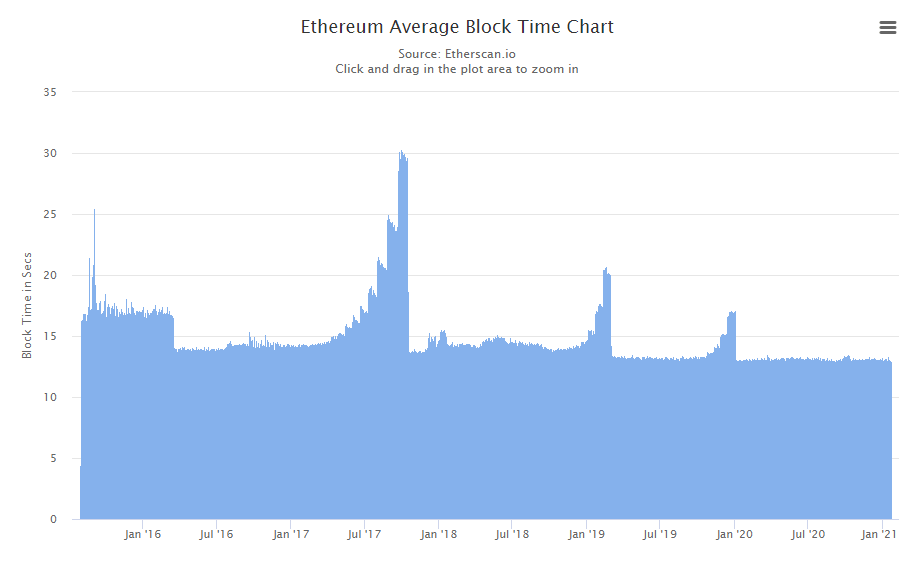
As you can see in the graph above from 15 seconds block time it gradually reduced to 13 seconds. Later we’ll explain how the block time got adjusted.
Now is the block rewards same as 5 ETH per block? No. From 5 ETH per block it was reduced to 3 ETH (-40%) which was adjusted by Byzantium hard fork. Later in Feb 2019 the Constantinople hard fork reduced the block reward from 3 to 2 ETH (-33%).
Currently the block reward is 2 ETH. Now there is also another proposal on reducing the rewards from 2 to 0.5 ETH (-75%). This is to preserve the purchasing power of Ethereum and bring its inflation rate closer to Bitcoin.
But this proposal is not finalized.
Source: https://ethereum-magicians.org/t/eip-2878-block-reward-reduction-to-0-5-eth/4500
Anyways who decides all these? How was the block time adjusted from 15 to 13 seconds and who decided to bring the block reward down from 5 to 2 ETH?
EIP – Ethereum Improvement Proposals
EIP stands for Ethereum Improvement Proposal. It is a document that covers the technical specification of the proposed change and the reason behind it. EIP is the common way of requesting and bringing changes to the Ethereum network which is inspired from Bitcoin Improvement Proposals (BIPs).
Not just the core dev team but anyone within the Ethereum community can make a request to bring changes to the Ethereum network. This is how the application standards and network upgrades for Ethereum are discussed and developed.
This is how the change in block time and block rewards was brought upon.
There are several EIPs (Ethereum Improvement Proposals) regarding block reward, block time, coin supply and consensus. It is an ongoing discussion and not every improvement proposal will be implemented.
For example to ensure the economic sustainability of the Ethereum platform co-founder Vitalik Buterin brought in an EIP to hard cap the Ethereum supply to 120 million. It is exactly the 2x the amount of ETH sold in the crowdsale. He also later suggested to cap the Ether supply to 144 million which is 2x the coins generated on genesis block. But both has not been accepted yet.
Source: https://github.com/ethereum/EIPs/issues/960
Over the years many developers and community members proposed multiple solutions regarding the Ethereum’s supply but none has been implemented. As of now the network supply still remains uncapped.
With no supply cap on Ether what will be the value of ETH in the future? What’s the totally amount of ETH that will be ever created and how is the inflation controlled?
Ethereum’s unlimited supply explained
How many Ether will ever exist? No one knows the exact number for this. But having no limit cap doesn’t mean that there will be tens or 100s of billions of Ether in the future.
Ethereum is one of such coin with no max supply that very well maintains its inflation rate. It plans to continue with slow and steady inflation. The two main factors that ensures the control of inflation are the block time and block rewards.
Like we said early on the issuance model on Ethereum is not fixed like Bitcoin. While Bitcoin has a build in halving mechanism, Ethereum relies on the EIPs (Ethereum Improvement Proposals) to control inflation.
Through EIPs so far Ethereum reduced the block reward twice from the original 5 ETH per block. This reduction in block reward is an effort to control inflation by reducing the newly available supply of ETH.
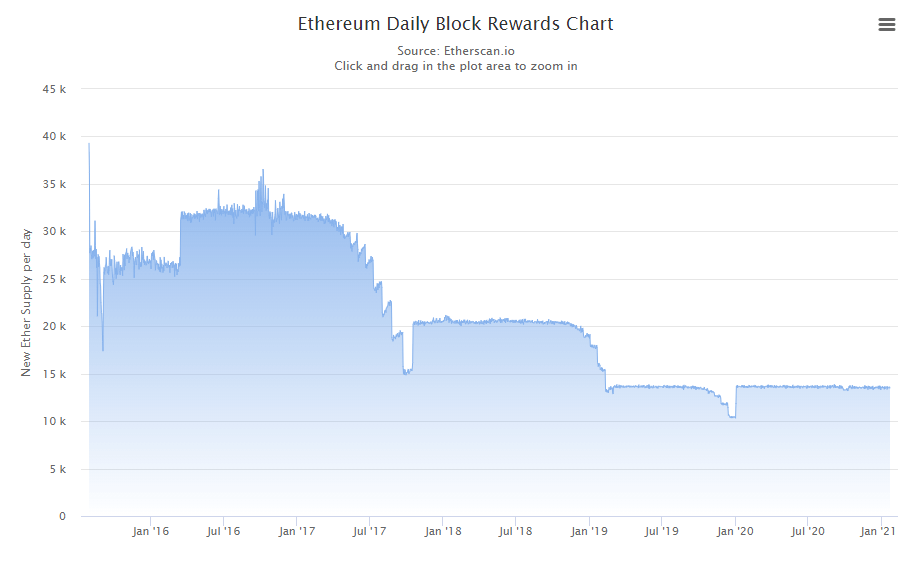
Just like how the block reward is reduced the block time is also adjusted through EIPs.
The average block time of Ethereum is 15 seconds but now the blocks are completed at approximately 13 second intervals. The speed per mined block got increased with Ice Age and is expected to drastically decrease with Casper implementation.
Initially 18 Million Ether were created each year which has been adjusted twice. Since the Constantinople hard fork which occurred on Feb 2019 there were no other adjustment made to the block rewards. This upgrade reduced the ETH supply from 20,300 to 12,300 ETH per day. This is 7.4 Million ETH per year to 4.9 Million ETH per year.
Since the genesis block which was launched in 2015 the total supply of Ether is on a constant rise. Approximately 10 percent every year. With the upcoming implementation of Casper protocol (Proof of Stake consensus protocol) the inflation rate is expected to be reduced from 10 percent to less than 2 percent per year. But the timeline for Casper implementation still remains uncertain.
Now let’s see the Ethereum’s current supply which is the circulating supply. What is the formula / calculation behind the total supply of Ether?
Current total supply of Ether
At the time of writing this article the total circulating supply of Ether is 114,367,939. Now not all these coins that are in circulation was issued through PoW mining. The majority of the coins were premined before the launch and was distributed in the genesis block.
Here is the distribution overview of Ether:
- Genesis Block: 72,009,990.50 Ether – 60 Million Crowdsale and 12 Million is the dev fund (0.2 coins per 1 coin sold in the pre-sale).
- Mining Block rewards: 39,558,466.41 Ether
- Mining Uncle Rewards: 2,799,482.13 Ether
Current Total Supply: 114,367,939.03 Ether
Source: https://etherscan.io/stat/supply
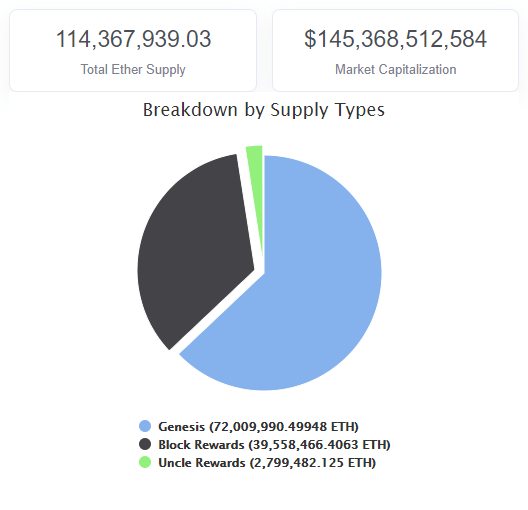
This is according to Etherscan. Now if you look at other block explorers the numbers will be slightly different. Why? This has been addressed in detail by crypto educator Andreas Antonopoulos.
This whole "what is ETH supply" thing is a silly gotcha that doesn't make much sense if you understand how Ethereum works. It's no better than the silly gotchas Schiff and Roubini level at bitcoin.
We can do better. Let's look at the details…
1/
— Andreas (@aantonop) August 10, 2020
So again if the blockchain is verifiable then why is there a problem in calculating the ETH supply and what is the official supply of ETH?
Official supply of ETH
In Bitcoin there is a build in function to query the supply. It is more easily verifiable with certain commands. For example anyone who is running a Bitcoin node can execute gettxoutsetinfo command and calculate the current supply.

Ethereum lacks such command and there is no simple method for verifying the supply in exact numbers.
Well there are certain third party scripts to calculate the total supply but not all of them will return the same results. It is not impossible to calculate but there are certain complexities.
1. First of all let’s look at the block time. Bitcoin solves 1 block in 10 minutes whereas Ethereum solves 40 in that time. So basically the time when you ask the question determines the answer. The numbers won’t be stable. Every 15 to 20 seconds it will change.
2. Next in Bitcoin Proof of Work the winner takes all the rewards for solving a block. Whereas in Ethereum along with block rewards there is a so called “uncle rewards” which needs to be taken into consideration. Other than uncle some rewards are further distributed to “nephews” (children of uncles).
Uncle blocks are blocks that nearly got into the blockchain but didn’t quite made it. They exist primarily to improve decentralization.
Learn what are uncle, orphan and stale blocks?
Both uncles and nephews form up 87% of the block reward. Moreover uncle blocks arrive with a delay of up to 6 blocks after the parent.
3. Then there is burned ETH which also needs to be taken into account. Burned ETH are nothing but Ether that has been permanently erased from the supply. This happens at times when a smart contract is set to self destruct. Most of the scripts won’t factor in the ETH that has been erased.
Hope you understood the complexity that lies behind calculating the total supply of Ether.
Hope the above information clears out everything you need to know about Ethereum supply.
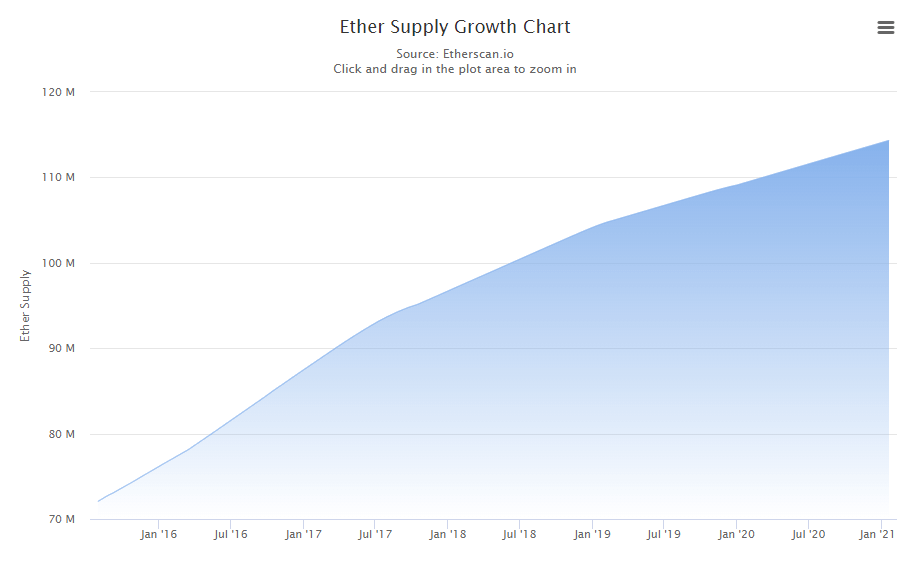
Currently the Ethereum supply is not capped. It slowly increases every year. Anyways with transition to PoS the issuance rate in the future will be greatly reduced.
Additional resources for Ethereum:
- Supply and market cap stats: https://etherscan.io/stat/supply
- Block count and rewards chart: https://etherscan.io/chart/blocks
- Supply growth chart: https://etherscan.io/chart/ethersupplygrowth
- Average block time chart: https://etherscan.io/chart/blocktime
If you found this article useful then please do share it. Also please follow us on social media to learn more about Bitcoin, Ethereum and other cryptocurrencies.



